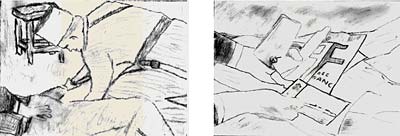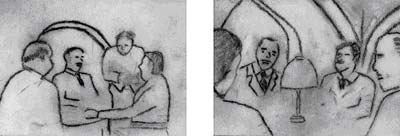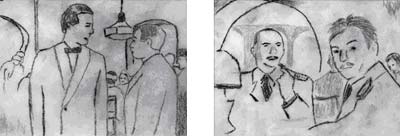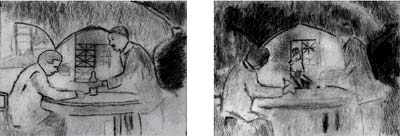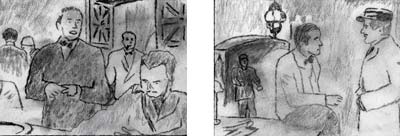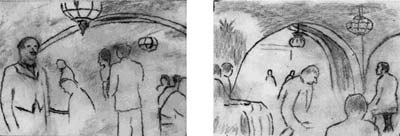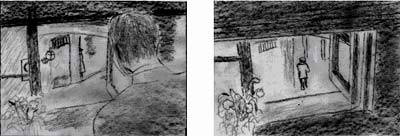|
In one of the opening scenes of Casablanca (Michael Curtiz, 1942), there is a shot that reveals something essential about why movies look the way they do: after hearing that two German couriers have been killed while carrying letters of transit - the MacGuffin of Casablanca - we see brief shots of the police authorities arresting suspicious characters in the streets of Casablanca. Among these characters is a middle-aged man whose papers are not in order; he tries to flee from the police but is gunned down. An officer bends down to the dead man, pulls some papers from his clenched hand (Fig. 1a) and passes them on to another officer closer to the camera who then unfolds the papers, which turn out to be Free France propaganda material (Fig. 1b). We see the close-up of the officer's hand holding the papers for a few seconds. But wait a minute… this shot seems slightly concocted. Is there something wrong about it? From a certain perspective, you might well say there is. For upon closer scrutiny, we find that the papers are awkwardly angled towards the camera - in fact, the officer holding these papers has a very poor view of them from where he is placed! From the perspective of passing on story information, however, the shot is logically staged. What counts above all is not what the character sees, but what WE see. This leads us to a statement that may be only too obvious: film images are not organized according to an inherent logic of character placement - they are organized in relation to the film viewer. This may not be true for all filmmaking, and indeed filmmakers committed to principles of truth or reality (or who follow other guidelines or restrictions in their work) often claim to be opposed to such intentionality. Nonetheless it offers a very useful approach to a study of why films look the way they do - particularly classical Hollywood films, the makers of which rarely if ever protest the claim that they stage and design visuals for the audience.
In this essay I will focus on a particular aspect of visual design and staging in Casablanca, namely the use of "aperture framings," i.e. the use of frames within the composition of shots.[1] Like other classical Hollywood films of the thirties and forties, Casablanca clearly prefers closed formal compositions as opposed to open one, and aperture framings play a prominent role in the visual design and staging of shots.[2] Incidentally, visual design refers here to the static organization within shots while visual staging refers to organizational shifts within shots. The Space Above For instance a contemporary American mainstream film relies too heavily on the visually dynamic to have characters seated around tables talking in almost half of its scenes! Nonetheless, I don't consider these types of compositions to be simple. In fact, the abundance of conversation scenes makes it even more interesting to note nuances in their design and staging.[3]
If we consider the two shots above, which feature characters seated at a table, we see how the arch-shaped vaulted ceiling neatly frames Major Strasser (Conrad Veidt) and Herr Heinz (Richard Ryen, to the right in Fig. 3), whilst simultaneously blocking off the otherwise empty space above them. On the basis of compositions like these, you might argue that the use of aperture framings is in fact an attempt to improve compositional balance, i.e. in this particular case someone - most likely Director of Photography Arthur Edeson - saw empty space above the characters' heads as a compositional problem that had to be tackled. Faced with an aspect ratio of 1:1.37 and set-ups that demanded the inclusion of, say, four characters within the shot, you are left with the choice of two visual playing fields - the space above the characters or the space below the waist. When such set-ups occur in Casablanca, the compositions are almost invariably cut off just below the characters' waists, thereby leaving space above their heads. The result is that there is a new playing field to work with and in this case the circular framing can be understood as a way of dealing with the space above. However, the use of aperture framings has implications that go beyond purely aesthetic issues of composition. For instance circular and arch-shaped framing devices are used even if there is no substantial space above the characters' heads to work with or to deal with. Indeed aperture framings can serve a variety of functions in a film. Besides formal compositional issues, there are at least three ways to account for the use of aperture framings in Casablanca. They are not mutually exclusive. 1. APERTURE FRAMING AS METAPHOR Regarding the metaphorical function of aperture framings, there also exists the slightly speculative possibility of assigning different meanings to different shapes of framing. In this context one could point out the confined narrow framing of Ugarte (Peter Lorre) and that of Major Strasser (Fig. 4 & 5) and claim that these particular "coffined" framings plant a seed of presentiment in the mind of the viewer that these characters will ultimately die. There is in fact some evidence that indicates a systematic use of these half-circle framings for Ugarte and Strasser (Fig. 2-5) whereas for instance Rick (Humphrey Bogart), Ferrari (Sydney Greenstreet), Herr Heinz and others are instead framed by quarter-circles or other shapes, though there are of course exceptions.
My main concern, however, is not with the actual meanings ascribed to the various frames, but rather to what extent aperture framings actually elicit notions such as confinement, claustrophobia, refuge, etc. That is, do these shots actually pass these notions on to the viewer or are they purely analytical constructs? Though I assume that the viewer's understanding of a character is at least influenced by the kind of frame that the character is placed in, it is difficult to prove exactly how the different framings are interpreted. Furthermore, metaphorical implications of aperture framings only seem to apply in specific dramatic contexts. As I will show later, a doorway frame around a certain character is not always a metaphor of entrapment. This makes it hard to see metaphorical framings as a broad-ranging staging strategy. My point is that assertions about metaphorical framings can be difficult to substantiate when trying to determine how framings are staged and designed in relation to the viewer. While it is definitely relevant to study metaphorical implications arising from the way characters are framed in a film, there are other approaches that may at first seem more mundane but on the other hand offer more fundamental explanations of why a movie like Casablanca looks the way it does. 2. DIRECTING ATTENTION Just a year or two prior to the release of Casablanca, Orson Welles and Gregg Toland had shown in Citizen Kane (1941) how to make good use of two other important intraframe narrative devices that the silent film makers didn't have at their disposal: sound and the extremely close foreground. While Casablanca generally doesn't make use of stationary long takes[6] or extremely close foregrounds in shots with substantial depth of field as does Citizen Kane, it is possible to detect how some of the same intraframe narrative strategies have been assimilated into the more orthodox découpage of Casablanca. Consider for instance the scene where Ilsa (Ingrid Bergman) comes to talk to Rick on the night of her arrival in Casablanca. This is just after the Paris flashback. The first shot after the flashback features a right to left camera movement from Rick's face to his hand that tips over a glass (just as Ilsa did in the flashback). The second shot features a left to right camera movement following Sam's (Dooley Wilson's) short walk to the right edge of the frame thus leaving open space between him and Rick in the very center of the shot. Here there is a door in the background which is itself framed by the vaulted ceiling. So in a sense it is a double aperture framing. The visual staging clearly prepares the viewer for the oncoming activation of this area of the shot where Ilsa will enter shortly after (Fig. 6a & b). The only object featured in the center of the shot is the bourbon bottle in front of Rick, but half a second before Ilsa enters, Rick removes the bottle to pour himself a drink thereby giving the viewer an unobstructed view of the entrance. In fact, this scene almost provides a catalogue of means to direct the viewer's attention towards a character's entrance. Beyond the measures already discussed, both Rick and Sam turn their heads toward the door; there is a musical cue; the foreground of the shot is darkened right before Ilsa enters and when she does, strong back lighting emphasizes that she is framed by the doorway.[7]
Other examples of aperture framings that focus attention on a specific character include for instance the staging of Rick's entrance to the gambling room and the staging of a French policeman coming to announce Major Strasser's arrival (Fig. 7 and 8). As a matter of fact, it could be argued that all of the examples I have mentioned in connection with compositional balance and metaphorical implications also direct attention toward the characters framed. Take for instance the shot of Strasser (Fig. 2). The framing does not necessarily carry metaphorical significance but simply singles Strasser out, thereby helping to draw attention to Strasser as a central character in the scene. This, of course, does not exclude the possibility of the framing also carrying metaphorical significance or its also serving the purpose of blocking off space above his head. Nevertheless, the purpose of directing attention presents a more fundamental and verifiable explanation for the way movies visually present themselves to the viewer.
3. APERTURE FRAMINGS AND MOOD: As to how aperture framings in Casablanca influence the mood of the film, I would argue that the white arch-shaped and circular framings inspired by Moorish architecture help establish a mood that can be described as exotic and mysterious. Films set in Western countries usually feature predominantly horizontal and vertical lines in the architecture surrounding characters, and hence these Moorish shapes evoke a milieu that is profoundly different. In a sense, it isn't the actual framing properties that are relevant here. The circular and arch-shaped white backgrounds are more important as a backdrop.
However, as we get into the drama of the story, the circular and arch-shaped whiteness of the background framings (Fig. 9-10) give way to dark quadrangular foreground framings (Fig. 11-12). The net is literally tightening around the characters and instead of creating an exotic and mysterious mood, the aperture framings now evoke a sense of danger and secrecy. Contributing greatly to this mood is the placement of the camera immediately behind these foreground framing devices, which serves to subjectify the shots. In other words, the connection between the viewer and the film is strenghtened by the inscription of a secret observer into the design of the shots. Again we are faced with the initial question of which subject position these shots are organized according to. Is it the omnipresence of the Nazis that is implied? Hardly, because in Fig. 12 Major Strasser is one of the observed. Furthermore, neither Fig. 11 nor 12 are part of a point-of-view sandwich. In fact, we cannot attribute the position of observer to anyone but ourselves. In two other shots that use dark foreground framing devices (Fig. 13 & 14), the observer position is ascribed to specific characters - Laszlo (Paul Henreid) and Ilsa respectively - by way of an over-the-shoulder shot and a point-of-view construction. Yet, even in these shots the sense of mood is primarily determined by the inscription of the viewer's presence as a secret observer. Laszlo's and Ilsa's observer positions simply focalize our view of the action.
Again the visual design of these shots (Fig. 13 & 14) gives cause to restate a claim made in the introduction of this essay. No matter how we choose to approach aperture framings - whether in terms of compositional æsthetics, metaphorical significance, directing attention or evoking a mood - in the final analysis their use is best understood from the same vantage point: determining how the visual design and staging is carried out in relation to the viewer. After all, the most important thing is what WE see.
| ||||||||||||||||||||||||||||||||||
| ||||||||||||||||||||||||||||||||||
